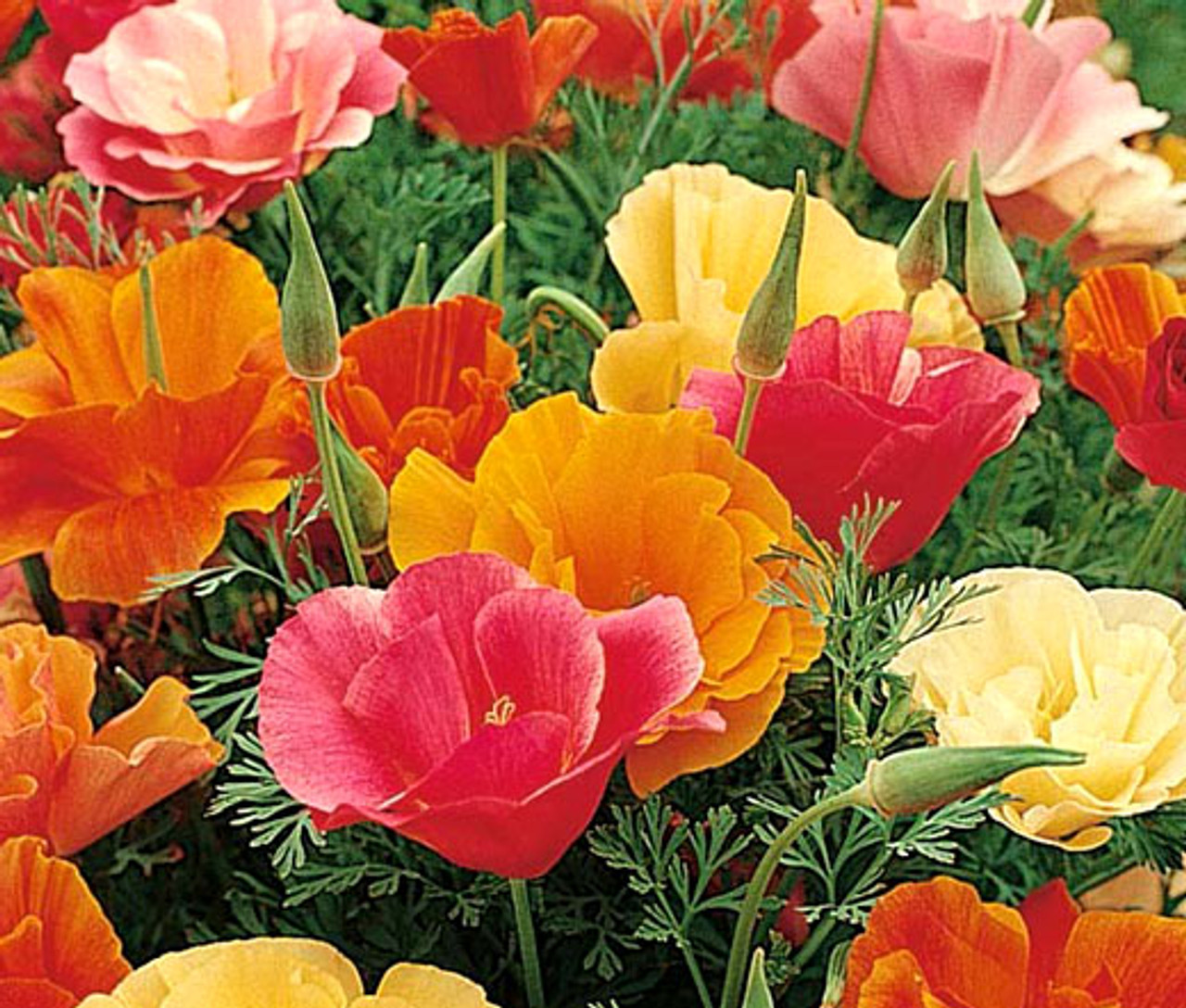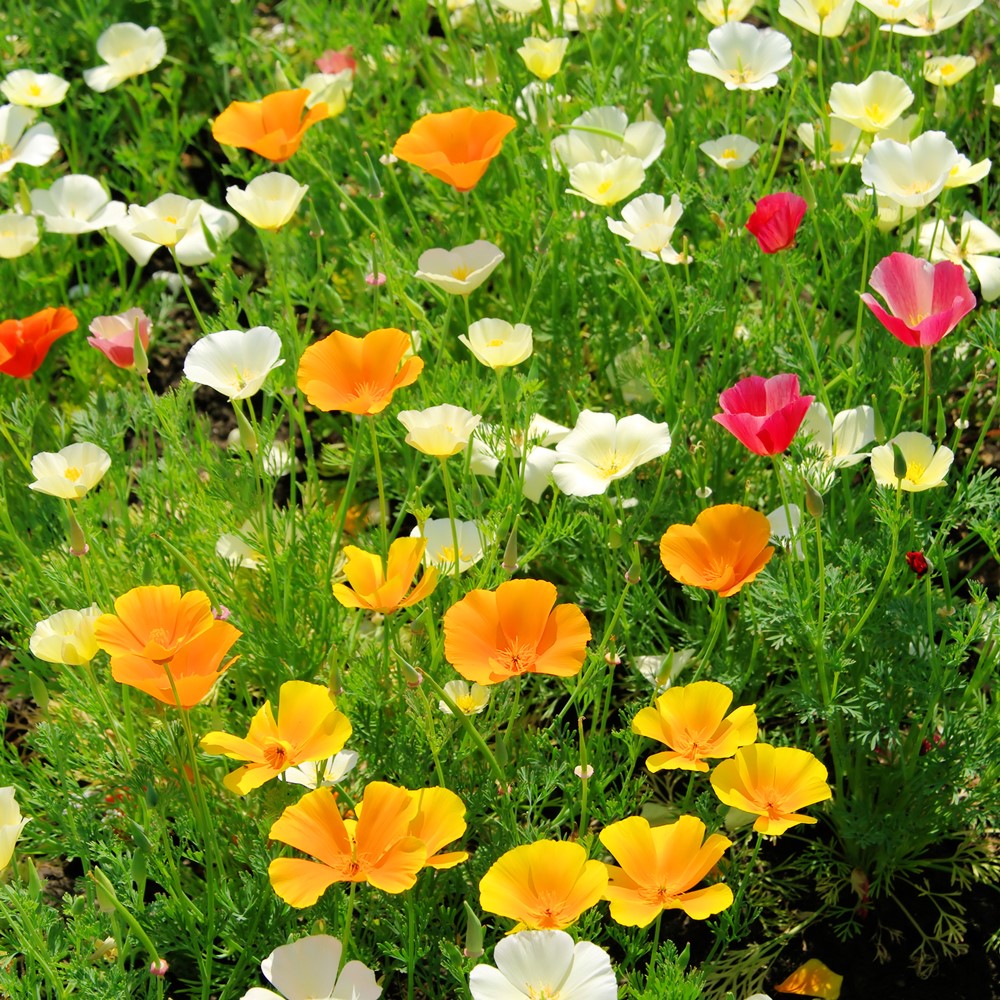
I’m often asked what is my favourite plant? Easily crowning the top of my list are the annual/perennial, prolifically self-seeding Californian poppies. Why? It’s because this poppy is what I call, the “it just does not, ever, ever shut up flowering” plant.
Their fantastic asset is the longevity and easy freedom of their effervescent froth of flowers. The delicate, silky textured, transparently thin petals come in the colour varieties of hot yellows, a rich range of oranges, the softest of pastels and cream and white. A sunny position is mandatory.
Even at night their flowers are still superb. The petal’s colours remain true when snapping tight shut at dusk to create a perfectly folded, whorled spiked shape, reminiscent of a grand field of mini tulips. And then, when the morning light arrives, they again unfurl their petals and produce yet another full day of stunning beauty and glamour.
The foliage itself is highly attractive with its feathery grey green leaves. They provide essential leaf contrast with their neighbouring plants, a vital ingredient in any good garden design. In winter they look marvelous with the morning frosts hanging heavy on the leaves.
Yes, many may call it an incorrigible weed, old fashioned, garish in colour, as common as dishwater. Well pity them. If it is indeed a weed it is a weed you have to have, which I will encourage forever and a day.

The poppies botanical name, Eschscholzia, must top the list for the most unpronounceable name of any plant, and after many years I forever still misspell it. Its name is all due to a certain Johann Friedrich Eschscholz, a zoologist, who was a member of an expedition that sailed to the Pacific coast of North America, way back in 1816, and it was his name that was used to identify this genus of poppy.
This genus belongs to the poppy family Papaveraceae. They are native to the California regions, found in semi-arid, prairies and pasturelands. and is the official flower emblem of the state. Thus, its common name is the Californian poppy.
The varieties available commercially in small pots include ‘Milky Way’ a cream colour, ‘Purple Gleam’ a dusty pale pink, and my total favourite, ‘Red Chief’ a vibrant red orange. There are also many great varieties available if planted from seed available in store or online.
The poppy is the first jump out of the winter doldrums and will continue to shine so stunningly until late autumn. A long succession of heavy winter frosts may subdue the proliferation of flowers somewhat and there is a week or two in the height of summer, when the plants seem exhausted and divert their energy to scattering their seeds magically far and wide, but so very quickly, they bounce back into their top flowering mode.
Cultivation
The Californian poppy is renowned for succeeding splendidly with little to no attention or care, growing in the most impoverished of soils, and in my own experience, even in heavy clay. However repeated applications of tonics and fertilisers, and frequent watering will result in even better well-rewarded greater blooming spectaculars. They adore the sun, for if they are planted in shade their flowers are reluctant to open.
Poppies just abhor a life in pots. Even from their infancy they are difficult to keep looking healthy when on offer in a nursery. This is because, like all poppies, they possess a single tap root and much prefer the open soil of the garden bed.
You will find that the flowers make the bees mighty happy. For me, the only drawback of the poppy, which is only minor, is that the ever-busy buzzing bees continually cross pollinate the flowers, and the newer self-seeding plants’ flowers, may well revert back to a single mid-orange or a canary yellow colour. But they are still beautiful in their richness of colour. The exception are the cream/white varieties which stay true to their colour, even at times transforming into the purest of clear whites. Simply heaven.

Design
Californian poppies are the ideal plants for cottage gardens, prairie landscapes, really any garden design, no matter how simple. They are perfect in my potager, great companions with the large rich purpled leaved cabbages, and with the other merrily proliferating self-seeding rich ruby ribbed silverbeets, parsley, spring onions, leeks, Tuscan kale and rocket.
You can throw them in with salvias and penstemons, seaside daisies, gauras, echinops and eryngiums and are perfect with the blue flowering convolvulus groundcover. Basically they can sex up any of the most dullest of surrounds.
They are a great friends and accompaniments with roses, masking and disguising their lower bare trunks and stems. In addition, they are the great answer for covering and camouflaging the unsightly withering leaves of spent bulbs such as tulips and daffodils.
Californian poppies are truly a must win plant for every garden. This is because of their magical beauty of both their flowers and foliage, the longevity of flowering period, their great bee attracting properties, their ease of care and their phenomenal self-seeding proliferation.
For me it the most valuable of plants, which my garden and myself could not live without. Long live the California poppy.
Happy gardening and have fun,
Regards Ned McDowell.